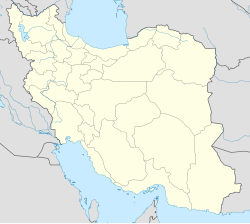Top Qs
Timeline
Chat
Perspective
Estahban
City in Fars province, Iran From Wikipedia, the free encyclopedia
Remove ads
Estahban (Persian: استهبان and Arabic: اصطهبانات)[a] is a city in the Central District of Estahban County, Fars province, Iran, serving as capital of both the county and the district.[5]
The area surrounding Estahban is very fertile,[3] being the largest producer of dried figs, saffron, grain, cotton, walnuts, almonds, grapes and other fruits in the Middle East. Estahban has been the most famous provider of figs to the world. It is also one of the biggest producers of saffron.[citation needed]
Remove ads
Demographics
Language, ethnicity, and religion
The majority of the people of Estahban are Persians, and they speak Persian with the Shirazi accent, not the Persian accent of Tehran. The majority in the city are Muslims.[citation needed]
Population
At the time of the 2006 National Census, the city's population was 33,101 in 8,714 households.[6] The following census in 2011 counted 34,639 people in 9,730 households.[7] The 2016 census measured the population of the city as 36,410 people in 10,970 households.[2]
Remove ads
Geography
Estahban is located at 29.1291° N, 54.358° E and surrounded by Bakhtagan Lake from the north, by Fars township from the south and by Shiraz and Darab from the west. Its average elevation from sea level is about 1767 m.[citation needed]
Climate
Estahban is a dry City, with a yearly precipitation amount of 224 millimeters, with summer temperatures frequently about 28.1 °C (104 °F) in blazing sunshine with no humidity.[citation needed]
Remove ads
Economy

Because of fertile soil, economy in Estahban is mostly based on agriculture and consequently significant portion of population is employed in agriculture industries. Estahban dried figs are exported all over the world.[citation needed]
Dried figs
Growing rain-fed and organically, having sweeter taste, drying naturally on tree and many health benefits make this fig unique.
There is no process for drying this product. Figs become dried by sun lights on the tree and then fall on the earth. Farmers collect them to warehouse to classify them.
Notable people
See also
Wikimedia Commons has media related to Estahban.
Notes
- Also romanized as Estahbān and Eşţahbān; before 1970 Eşţahbānāt, also romanized as Estehbanat, Istahbanát, Istehbānāt,[3] and Shahr-e Eşţahbānāt; also formerly known as Savānāt.[4] Also formerly known as Naseri, rooted in the Pahlavi word seteh and the suffix ban, which means "a place for keeping grapes"
References
Wikiwand - on
Seamless Wikipedia browsing. On steroids.
Remove ads


